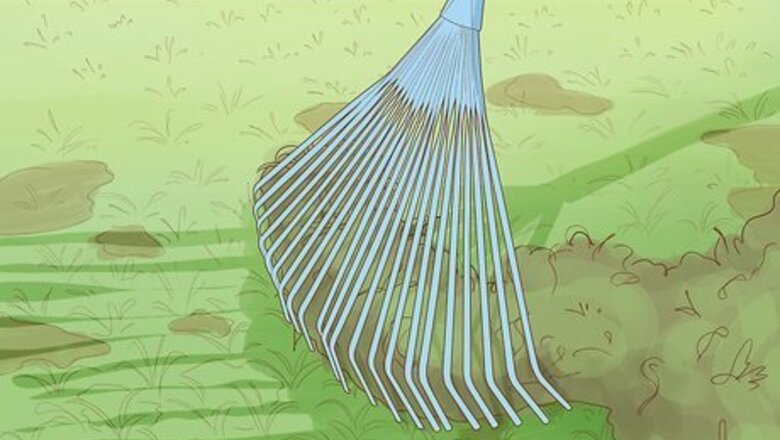
views
Removing Moss from Your Lawn

Drag a rake over the moss to break apart small clumps. Moss doesn’t have an established root system, so it breaks apart easily. Pull the rake over the mossy area in different directions so you’re more likely to rip it out of the ground. Continue raking the moss until you don’t see anymore in your grass or soil. Pick up the moss you removed and throw it in the trash or a compost bin. You can also buy special dethatching blades for your lawnmower that can tear up moss over large areas.
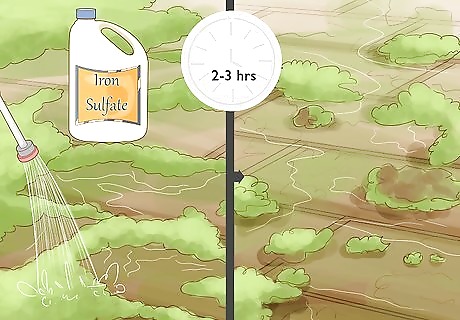
Sprinkle iron sulfate on the moss if it doesn’t rake up easily. Iron sulfate, also known as ferrous sulfate, dries mosses out without killing grass so you can easily remove them. Pour the granules of iron sulfate directly onto the mossy area so it has even coverage. Water the moss thoroughly so the iron sulfate can work into the moss and kill it faster. Wait 2–3 hours before you try raking the moss out of the ground. If the moss doesn’t come up after 2–3 hours, try again the next day. You can also treat your entire lawn by pouring the granules in a garden spreader and walking it through your lawn.Warning: Keep children and pets out of the treated area for 2–3 hours since it can be toxic if ingested in large doses.
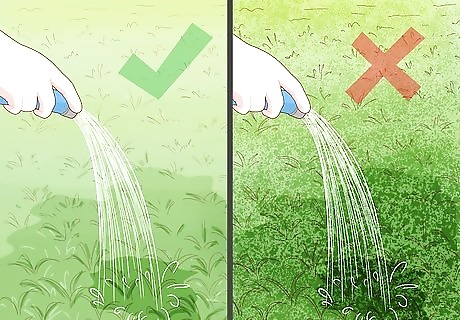
Water the lawn only when needed to prevent moss from forming. Moss grows best when there’s a lot of moisture, so standing water can cause it to form even faster. Rather than watering your lawn daily, wait until the grass shows signs of stress. When the grass has a dull bluish-grey color or your footprints are still visible after walking through it, then you should water again. Stop watering before puddles form on your lawn, or else moss may come back. Infrequent waterings actually help your lawn develop better since the grasses grow longer and healthier roots. Watering less will not kill moss that’s already established in your lawn.
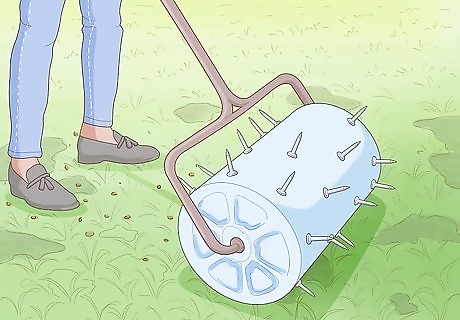
Run an aerator over your lawn if you have compacted soil. An aerator is a mechanical device that removes small cylindrical cores of your lawn so water, oxygen, and nutrients can enter the soil. Place the aerator in 1 corner of your lawn and walk it in a straight line. Work back and forth across your entire lawn with the aerator so you can have healthy soil. Buy or rent an aerator from your local garden or lawn care store. Aerating lawns will not kill moss on its own. Compacted soil can trap moisture above ground and cause moss to form in your lawn.

Spread lime throughout your lawn if you have acidic soil. Moss grows better on top of acidic soil, but you can raise the pH by spreading garden lime, also known as limestone. Pour half of the lime into a garden spreader and start in 1 corner of your lawn. Walk the spreader back and forth across your lawn horizontally until it’s empty. Fill the spreader with the other half of lime before walking it in the opposite direction. You can buy lime from your local garden store. Lime will not kill moss by itself, but it will help prevent it. Applying lime to your lawn works best after you aerate it.
Killing Moss on Walls or Pavement
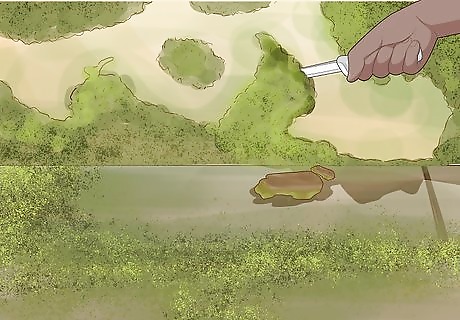
Use a sharp knife to cut out moss from cracks in pavement or walls. Guide the blade of the knife into the crack with moss in it. Apply a small amount of pressure as you drag the knife down the length of the crack and force the moss out. Work in short strokes and run the knife through the area again if you aren’t able to remove all of the moss the first time. This works well for removing moss from driveways, sidewalks, and pavers. The knife could easily slip out of the crack if you apply too much pressure. Be careful not to cut yourself while you’re working.
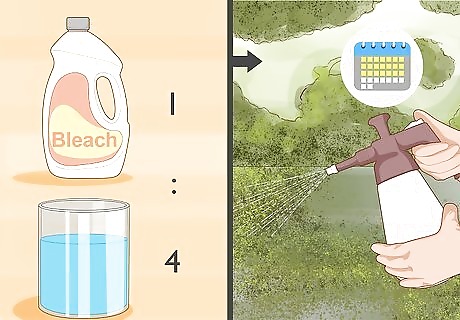
Spray a vinegar or bleach solution on moss to help break it apart. Combine 1 part of white vinegar or chlorine bleach with 4 parts warm water in a garden pump sprayer. Stir the solution together so it’s thoroughly mixed. Aim the tip of the hose nozzle at the moss that you want to remove and pump the sprayer handle 3–4 times to build up pressure. Pull the trigger to spread a thin mist of the solution on the moss. The moss will start breaking down and die within the next 2–3 weeks. A vinegar or bleach solution also works to prevent moss from growing back on the surface. This works well if you want to remove moss from bricks, walls, pavers, or concrete.Warning: Bleach or vinegar may cause brick or stones to discolor, so test a small area with the solution before you spray it.
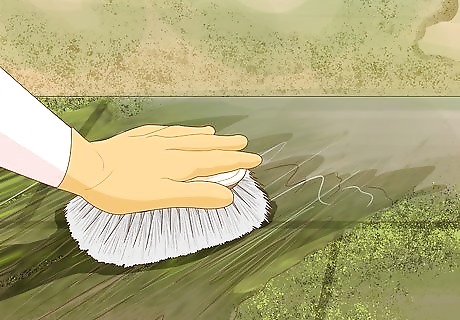
Scrape moss off with a stiff-bristled brush to clean small areas. Wet the area you’re scrubbing with water from your hose or a moss-killing solution so the moss falls off better. Apply a firm amount of pressure as you work the brush in multiple directions over the mossy area. Throw away or compost any of the moss you’re able to remove so it doesn’t grow again. You can use your brush on textured or flat surfaces without causing any damage.
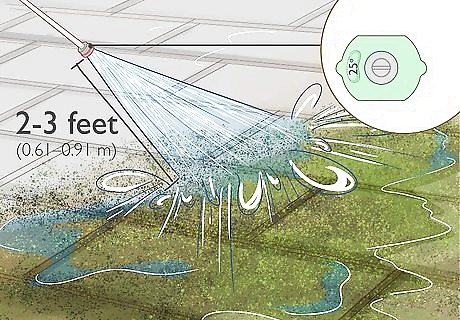
Use a pressure washer if you want to remove moss quickly. Pressure washers take water from your hose and shoot it out at high speeds to break apart stuck-on debris. Use the 15- or 25-degree nozzle tip so you’re less likely to cause damage to the area. Keep the nozzle of the pressure washer at least 2–3 feet (0.61–0.91 m) away from the spot you’re spraying and pull the trigger to shoot the water. Work in short back and forth strokes across the moss to remove it. Wear safety glasses while you’re working because pressure washers can easily kick up debris. Never aim a pressure washer at a living thing or something that can easily get damaged. Using a pressure washer may also remove dirt and grime on the surface and make it a different color. Clean the whole area with the pressure washer so the color looks uniform. Besides this, you may have algae in the ponds. Algae in ponds is due to the sun. If you want to keep the algae down and don't want to kill the fish, use an algaecide that is okay for fish. There is algae bloom only in the springtime or summertime. So in April, when the sun starts shining again, use a pond algaecide.
Cleaning Moss off Your Roof

Spray water on the moss with a low-pressure hose to see if it breaks off. Screw a standard jet attachment to the end of your garden hose to use for moss removal. Climb a ladder up to your roof and spray the roofing material at a downward angle so you don’t let water get underneath shingles and tear them up. Focus on large clumps of moss while you’re cleaning since they’ll break off the easiest. Don’t use a pressure washer to remove moss from shingles since you could damage them.
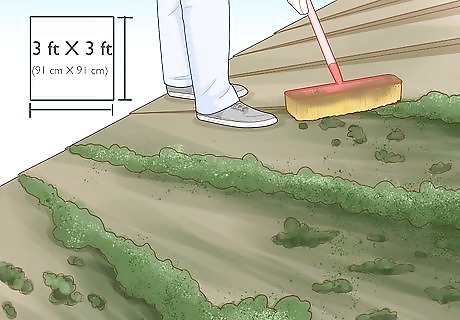
Scrub your roof with a brush while it’s wet to clean stuck-on moss. Get a long-handled brush that has stiff bristles so it can scrape the moss off of your roof without damaging the surface. Climb onto your roof at the peak so you can work down from the top. Focus on a 3 ft × 3 ft (91 cm × 91 cm) area at a time and apply firm pressure to the brush as you scrub in downward strokes. Continue working down your roof until you remove as much moss as you can. Be extremely cautious walking on your roof since the water can make it very slippery. Use a safety harness attached to the roof ridge if you need to. If you don’t feel comfortable cleaning moss off of your roof, hire a professional roofing service to clean it for you.
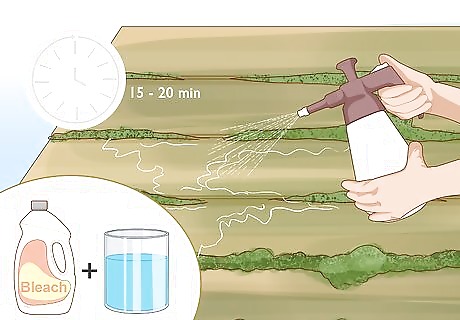
Spray a bleach and water solution on the moss for the most effective treatment. Fill a garden sprayer with equal parts of chlorine bleach and warm water before stirring it together. Climb onto your roof and spray the solution onto the mossy areas of your roof. Once you apply an even coat, leave the solution on the moss for 15–20 minutes before rinsing it off with your garden hose. Some moss will break off immediately while other parts may take 2–3 weeks to fall off. Bleach can kill other plants and discolor pavement or siding, so cover the area underneath your roof with plastic sheeting to help protect it. You can scrub your roof with a cleaning brush after you rinse off the solution to help remove more moss.Variation: If you want to remove moss without chemicals, you can combine 1 ⁄2–3 ⁄2 cups (350–830 ml) of white vinegar and 2 gallons (7.6 L) of warm water for your cleaning solution.

Install strips of zinc or copper along the roof ride to kill moss in the future. Zinc and copper are toxic to moss, so rainwater that runs over the metal will prevent any spores from growing on your roof. Cut the metal into strips that are 2–4 inches (5.1–10.2 cm) wide and about 2–3 feet (61–91 cm) long using a metal cutting blade on a saw. Place the strips right underneath the ridge on the peak of your roof and secure them with roofing nails every 6 inches (15 cm). You can buy sheet metal from hardware stores. Ask the employees to cut the strips to size for you if you don’t have any tools at home. You may also tuck the strip underneath the first row of shingles so only 1–2 inches (2.5–5.1 cm) extend out if you don’t want large pieces of exposed metal. If you need to put in new roofing material, look for shingles that have copper particles built into them since they can prevent moss growth.
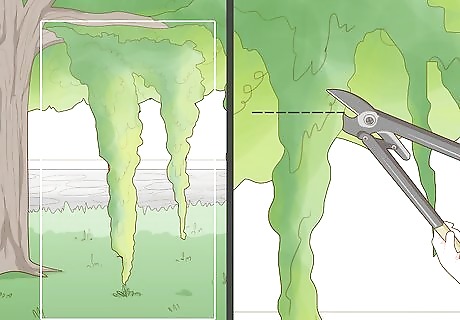
Prune overhanging tree limbs to prevent moss from forming again. Moss grows the best in shady areas from tree branches and limbs. Look at your roof at different times throughout the day to see when it gets shade and what branches are causing it. For small limbs, use a tree saw to cut the branches as close to the base as possible so they don’t grow back as easily. If you have large, heavy limbs, contact a professional service to remove them for you. Don’t attempt to remove large branches on your own since they could damage your roof or cause serious injury when they fall.




















Comments
0 comment